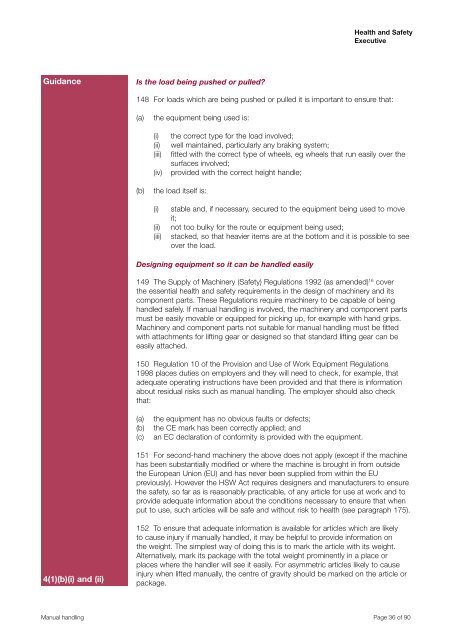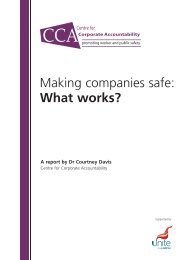Manual Handling Manual Handling Operations Regulations 1992 ...
Manual Handling Manual Handling Operations Regulations 1992 ...
Manual Handling Manual Handling Operations Regulations 1992 ...
You also want an ePaper? Increase the reach of your titles
YUMPU automatically turns print PDFs into web optimized ePapers that Google loves.
Health and Safety<br />
Executive<br />
Guidance<br />
Is the load being pushed or pulled?<br />
148 For loads which are being pushed or pulled it is important to ensure that:<br />
(a)<br />
the equipment being used is:<br />
(i)<br />
(ii)<br />
(iii)<br />
(iv)<br />
the correct type for the load involved;<br />
well maintained, particularly any braking system;<br />
fitted with the correct type of wheels, eg wheels that run easily over the<br />
surfaces involved;<br />
provided with the correct height handle;<br />
(b)<br />
the load itself is:<br />
(i)<br />
(ii)<br />
(iii)<br />
stable and, if necessary, secured to the equipment being used to move<br />
it;<br />
not too bulky for the route or equipment being used;<br />
stacked, so that heavier items are at the bottom and it is possible to see<br />
over the load.<br />
Designing equipment so it can be handled easily<br />
149 The Supply of Machinery (Safety) <strong>Regulations</strong> <strong>1992</strong> (as amended) 16 cover<br />
the essential health and safety requirements in the design of machinery and its<br />
component parts. These <strong>Regulations</strong> require machinery to be capable of being<br />
handled safely. If manual handling is involved, the machinery and component parts<br />
must be easily movable or equipped for picking up, for example with hand grips.<br />
Machinery and component parts not suitable for manual handling must be fitted<br />
with attachments for lifting gear or designed so that standard lifting gear can be<br />
easily attached.<br />
150 Regulation 10 of the Provision and Use of Work Equipment <strong>Regulations</strong><br />
1998 places duties on employers and they will need to check, for example, that<br />
adequate operating instructions have been provided and that there is information<br />
about residual risks such as manual handling. The employer should also check<br />
that:<br />
(a)<br />
(b)<br />
(c)<br />
the equipment has no obvious faults or defects;<br />
the CE mark has been correctly applied; and<br />
an EC declaration of conformity is provided with the equipment.<br />
151 For second-hand machinery the above does not apply (except if the machine<br />
has been substantially modified or where the machine is brought in from outside<br />
the European Union (EU) and has never been supplied from within the EU<br />
previously). However the HSW Act requires designers and manufacturers to ensure<br />
the safety, so far as is reasonably practicable, of any article for use at work and to<br />
provide adequate information about the conditions necessary to ensure that when<br />
put to use, such articles will be safe and without risk to health (see paragraph 175).<br />
4(1)(b)(i) and (ii)<br />
152 To ensure that adequate information is available for articles which are likely<br />
to cause injury if manually handled, it may be helpful to provide information on<br />
the weight. The simplest way of doing this is to mark the article with its weight.<br />
Alternatively, mark its package with the total weight prominently in a place or<br />
places where the handler will see it easily. For asymmetric articles likely to cause<br />
injury when lifted manually, the centre of gravity should be marked on the article or<br />
package.<br />
<strong>Manual</strong> handling Page 36 of 90
















